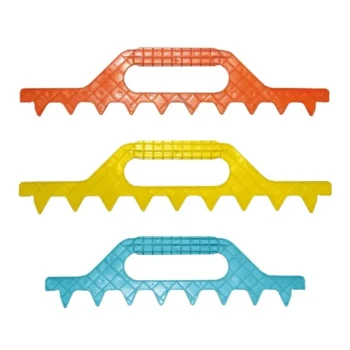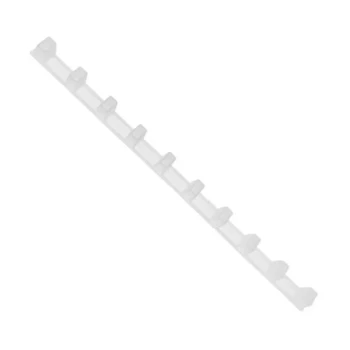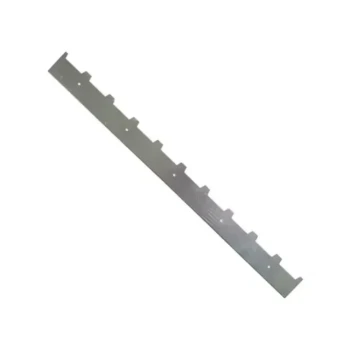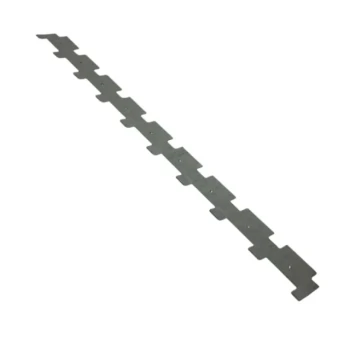Using nine frames in a ten-frame box is a standard management technique used by beekeepers, primarily for honey production. You achieve this by first allowing the bees to build, or "draw out," the comb on all ten frames. Once the comb is established, you remove one frame and then space the remaining nine evenly across the box to create wider gaps between each frame.
The standard ten-frame configuration can be tight, making hive inspections difficult and honey extraction less efficient. Running nine frames in a ten-frame honey super leverages the bees' natural tendencies to make inspections easier and, more importantly, to create deeper honey cells that simplify the uncapping process.

The Principle of 'Bee Space'
To understand why this technique works, you must first understand the concept of "bee space." This is the foundational principle of all modern, movable-frame beekeeping.
What is Bee Space?
Bee space is the specific gap, measuring between 1/4 inch and 3/8 inch (6 to 9 mm), that bees naturally maintain between their combs. They keep this space clear as a pathway to move throughout the hive.
The Problem with Incorrect Spacing
If a gap is smaller than bee space, bees will seal it shut with propolis, a resinous "bee glue." If a gap is larger than bee space, bees will fill it with extra comb, often called burr comb or cross comb. This unwanted comb makes it nearly impossible to remove frames without damaging them and angering the hive.
How 9-in-10 Spacing Works
By spacing nine drawn frames within a ten-frame box, you intentionally create gaps that are slightly larger than bee space between the comb surfaces. Because the comb structure is already established, the bees will not build new comb in the gaps. Instead, they will extend the existing cells outward.
The Goal: Maximizing Honey Extraction Efficiency
While some beekeepers find the extra room helpful for inspections, the primary driver for this technique is to improve the honey harvesting process.
Encouraging Deeper Honey Cells
When you create the wider spacing in a honey super, the bees will continue building the wax honey cells outward, making them deeper than they would be in a standard 10-frame setup. This allows each frame to hold slightly more honey.
Simplifying Uncapping
The most significant benefit comes during extraction. Because the cells are deeper, the wax cappings that seal the honey will be raised well above the wooden parts of the frame. This allows you to use an uncapping knife to slice off the cappings in one clean, easy pass without hitting the wood.
Making Supers Easier to Work
With one less frame, the box is slightly lighter. More importantly, the extra room makes it significantly easier to pry the first frame loose during an inspection, reducing the risk of rolling and killing bees.
Understanding the Trade-offs and Risks
This technique is highly effective but must be implemented correctly and used only in the proper context. Misusing it will create significant problems.
The Critical First Step: Start with Ten Frames
You cannot place nine empty frames with new foundation into a ten-frame box. The bees will see the large gaps between the foundations as empty space to be filled and will build uncontrolled burr comb, creating a mess that is difficult or impossible to fix. You must start with ten frames until the comb is fully drawn.
Not Ideal for the Brood Box
This technique is strongly discouraged for brood boxes, where the queen lays her eggs. Queen bees prefer a consistent cell depth for laying a uniform brood pattern. Wider, deeper cells can disrupt this pattern and may encourage the bees to build an excess of larger "drone" cells, leading to an overpopulation of male bees.
Requires Even Spacing
After removing the tenth frame, you must manually center the remaining nine. If you push them all to one side, the bees will build burr comb in the large gap you've created. Many beekeepers use a frame spacing tool or a hive tool to ensure the gaps are uniform.
How to Apply This to Your Hive
Choosing the right configuration depends entirely on the purpose of the hive box.
- If your primary focus is honey production: Use the 9-frame configuration in your honey supers after the comb is drawn to get deeper honey cells and simplify your extraction process.
- If your primary focus is brood rearing: Stick with the standard 10-frame configuration in your brood boxes to provide the queen with a consistent laying environment and maintain colony health.
By understanding how and when to manipulate frame spacing, you can work more effectively with your bees to achieve your specific beekeeping goals.
Summary Table:
| Application | Recommendation | Key Benefit |
|---|---|---|
| Honey Supers | Use 9 frames (after comb is drawn) | Deeper honey cells for easier extraction |
| Brood Boxes | Use standard 10 frames | Consistent environment for queen & brood health |
| Implementation | Start with 10 frames, then remove one | Prevents burr comb; ensures proper spacing |
Ready to maximize your honey production and streamline your workflow?
As a trusted wholesale supplier to commercial apiaries and equipment distributors, HONESTBEE provides the durable, high-quality supers and frames you need to implement techniques like the 9-in-10 method effectively. Our equipment is designed for the demands of professional beekeeping.
Contact our expert team today to discuss your wholesale needs and discover how our supplies can help your operation run more smoothly and profitably.
Visual Guide
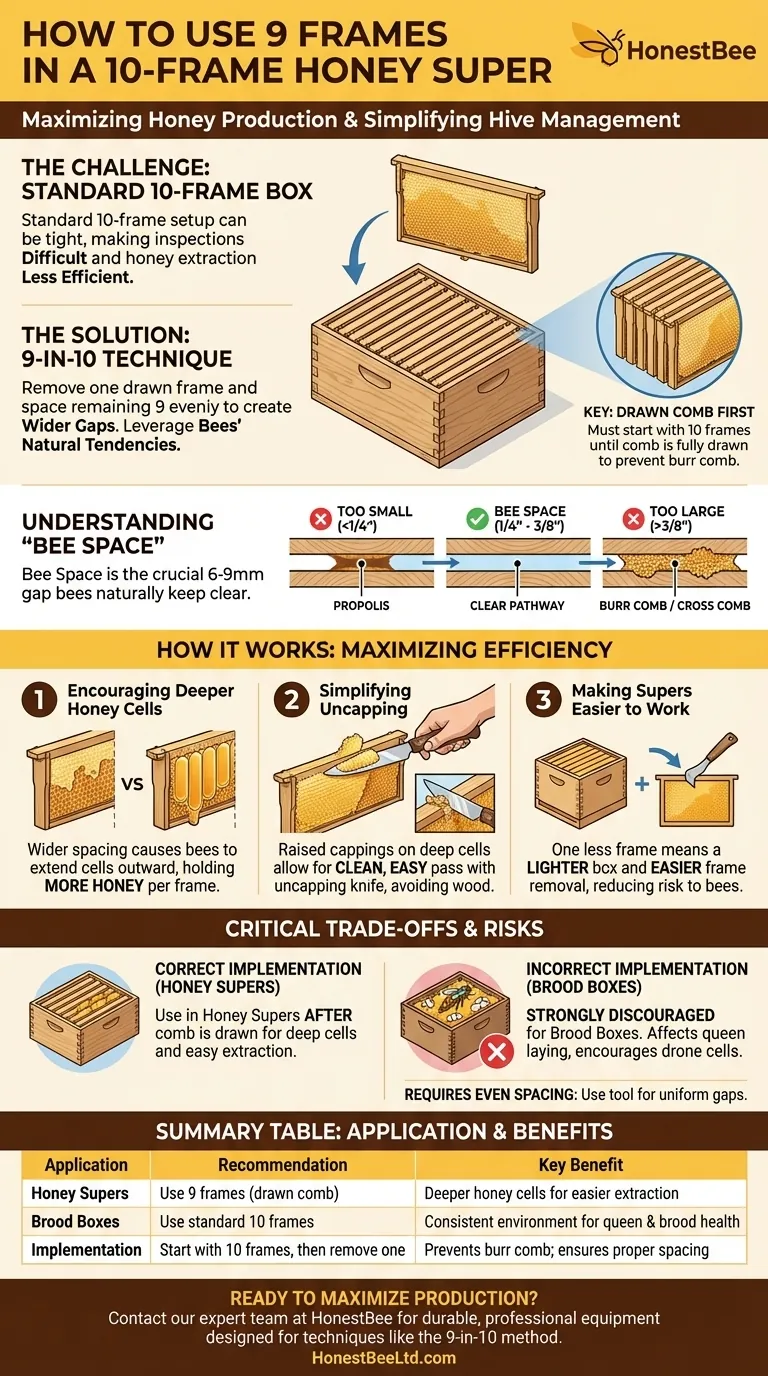
Related Products
- Stainless Steel 9 Frame Hive Spacer Durable Precise for Commercial Beekeeping
- Ergonomic Plastic Frame Spacer Tool for Rapid Hive Management Beekeeping
- Durable Plastic Frame Spacer
- Heavy-Duty Stainless Steel Frame Grip
- Professional Castellated Iron Frame Spacer for Multiple Hive Types
People Also Ask
- What is 'bee space' in beehive construction? The Key to Modern, Manageable Beekeeping
- What to do if bees are building combs between frames? A Guide to Fixing Burr Comb
- Why is it important to compress frames together in the center of the box after reassembly? Prevent Burr Comb and Hive Chaos
- What is the recommended number of frames for a beginner beekeeper? The Essential Rule for a Healthy Hive
- How often should beehive frames be inspected and cleaned? A Guide to Hive Health & Honey Quality

